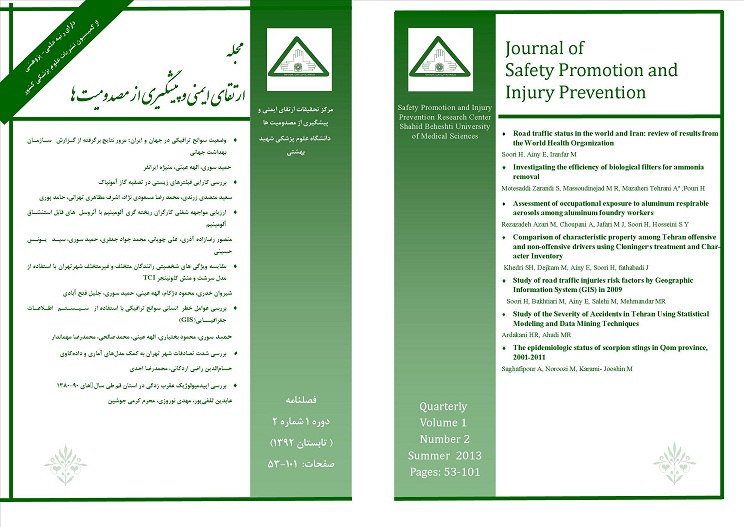...
ارتقای ایمنی و پیشگیری از مصدومیت ها,
دوره 1 شماره 2 (2013),
7 September 2013
,
صفحه 63-68
https://doi.org/10.22037/meipm.v1i2.4972
چکیده
Backgrounds and Aims: Ammonia removal from air to prevent severe damage to the environment and living organisms is very important. Biofiltration is an efficient, easy, cost-effective, and environmentally friendly process for degradation of ammonia from waste air. The aim of this study is to investigate the efficiency of biological filtration using a compost and scallop bed for ammonia removal.
Materials and Methods: According to the ammonia removal method a column with 14cm inner diameter and 45cm height made from transparent Plexiglas was used. The column was filled up to 25 cm with compost and scallop (with a scallop: compost ratio of 1:4).
In this study, performance of the biofilter was studied under 10 different flow rates (1, 2, 3, 4, 5, 6, 7, 8, 9 and 10 lit/min) and 5 different concentrations (0-20, 20-40, 40-60, 60-80 and 80-100 ppm) at a temperature of 25 degrees Celsius.
Results: The results of this study showed that efficiency is decreased when the flow rate or concentration is increased because the microbial population is reduced. The efficiency was reduced by 84.6-98.2 percent. Maximum efficiency occurred at a 0.19g/(m3.h) loading rate. Efficiency was in 0-20 concentration intervals at a flow rate of 1 lit/min and at an Empty Bed Residence Time (EBRT) of 240 seconds.
Conclusion: The results show that a biofilter with a compost and scallop bed is efficient for ammonia removal from air. Results can be optimized in the design and operation of biological systems to be used in the industrial control of ammonia gas.
How to cite this article: Motesaddi Zarandi S Massoudinejad MR, Mazaheri Tehrani A, Poori H. Investigating the Efficiency of Biological Filters for Ammonia Removal. Irtiqa Imini Pishgiri Masdumiyat (Safety Promotion and Injury Prevention).2013;1(3):63-68.
- Air Pollution
- Ammonia
- Biofilter
ارجاع به مقاله
- چکیده مشاهده شده: 624 بار
- PDF (English) دانلود شده: 62 بار
- PDF دانلود شده: 46 بار
